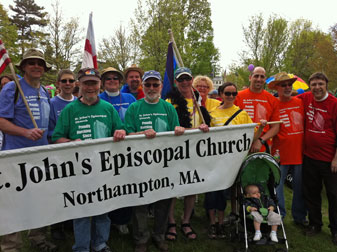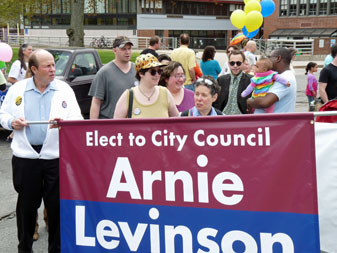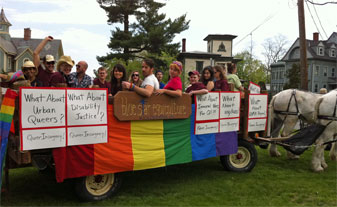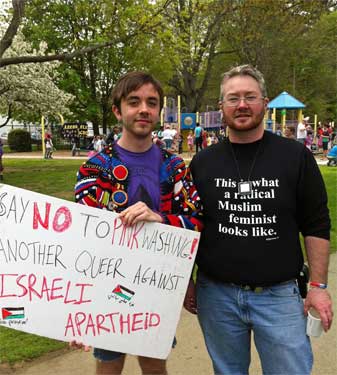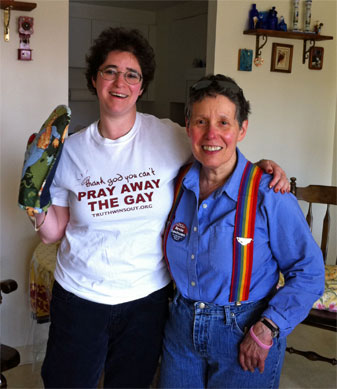Yesterday, the New York State legislature passed and Gov. Andrew Cuomo signed legislation that will give same-sex couples the right to marry! According to the Vermont Freedom to Marry press release: “Joining Connecticut, Iowa, Massachusetts, New Hampshire, Vermont, and Washington, D.C., New York becomes the most populated state to achieve marriage equality, and more than doubles the number of both same-sex couples and of Americans living in a state with marriage equality.”
Other organizations that deserve your thanks and financial support for their hard work on this legislation include the Human Rights Campaign, GetEqual, Courage Campaign, Freedom to Marry, and Other Sheep. If you live in Buffalo, give a shout-out (and your vote) to Sen. Mark Grisanti, a Catholic Republican who cast one of the swing votes for the bill in the Senate last night.
The full text of the legislation is here. An excerpt:
Marriage is a fundamental human right. Same
sex couples should have the same access as others to the protections,
responsibilities, rights, obligations, and benefits of civil marriage.
Stable family relationships help build a stronger society. For the
welfare of the community and in fairness to all New Yorkers, this act
formally recognizes otherwise-valid marriages without regard to whether
the parties are of the same or different sex.It is the intent of the legislature that the marriages of same-sex and
different-sex couples be treated equally in all respects under the law.
The omission from this act of changes to other provisions of law shall
not be construed as a legislative intent to preserve any legal
distinction between same-sex couples and different-sex couples with
respect to marriage….***
…A MARRIAGE THAT IS OTHERWISE VALID
SHALL BE VALID REGARDLESS OF WHETHER THE PARTIES TO THE MARRIAGE ARE OF
THE SAME OR DIFFERENT SEX.
2. NO GOVERNMENT TREATMENT OR LEGAL STATUS, EFFECT, RIGHT, BENEFIT,
PRIVILEGE, PROTECTION OR RESPONSIBILITY RELATING TO MARRIAGE, WHETHER
DERIVING FROM STATUTE, ADMINISTRATIVE OR COURT RULE, PUBLIC POLICY,
COMMON LAW OR ANY OTHER SOURCE OF LAW, SHALL DIFFER BASED ON THE PARTIES
TO THE MARRIAGE BEING OR HAVING BEEN OF THE SAME SEX RATHER THAN A
DIFFERENT SEX. WHEN NECESSARY TO IMPLEMENT THE RIGHTS AND RESPONSIBIL
ITIES OF SPOUSES UNDER THE LAW, ALL GENDER-SPECIFIC LANGUAGE OR TERMS
SHALL BE CONSTRUED IN A GENDER-NEUTRAL MANNER IN ALL SUCH SOURCES OF
LAW.
…
It remains to be seen how broadly the religious exemptions will be construed. The relevant text reads:
A CORPORATION INCORPORATED UNDER THE BENEVOLENT ORDERS
LAW OR DESCRIBED IN THE BENEVOLENT ORDERS LAW BUT FORMED UNDER ANY OTHER
LAW OF THIS STATE OR A RELIGIOUS CORPORATION INCORPORATED UNDER THE
EDUCATION LAW OR THE RELIGIOUS CORPORATIONS LAWS SHALL BE DEEMED TO BE
IN ITS NATURE DISTINCTLY PRIVATE AND THEREFORE, SHALL NOT BE REQUIRED TO
PROVIDE ACCOMMODATIONS, ADVANTAGES, FACILITIES OR PRIVILEGES RELATED TO
THE SOLEMNIZATION OR CELEBRATION OF A MARRIAGE.
Few would argue that clergy should be forced to perform marriages that don’t meet their denomination’s doctrinal requirements, or to use church property for the same. I would imagine that even without this provision, a First Amendment claim would be resolved in the church’s favor. But what other “privileges” or “accommodations” might they try to withhold? Could a religious hospital block a gay spouse from visiting and making medical decisions for an incapacitated partner? Hopefully, courts will construe this clause narrowly as only applying to the actual ceremony (“solemnization or celebration”), not to the legal status (“a marriage”) that follows from it.
All in all, a great day for justice and freedom! Hooray New York!
